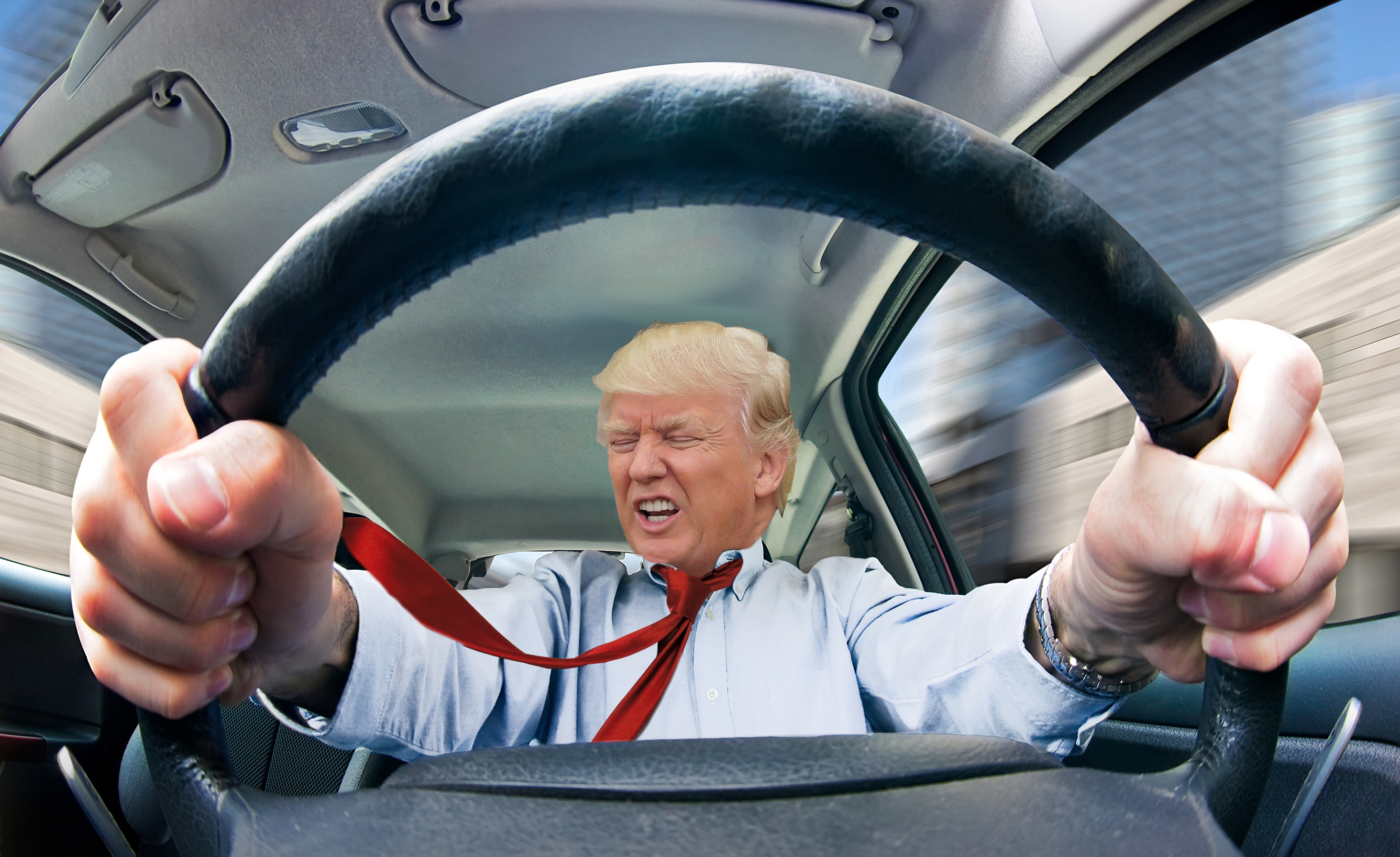Trump is losing control of his trade war
If he ever had it, that is


President Trump isn't just losing his trade war — he's losing his grip on it.
Trump already imposed tariffs on $34 billion worth of Chinese imports, and Beijing has responded in kind. Now Trump is threatening to crank it up to $500 billion — nearly the entirety of what China sends to the U.S. Beyond China, Trump is publicly musing about tariffs on all imported cars and parts. Of course, all of this is infuriating major world powers, which could harm Trump's own voters.
Trump badly needs to lay out his endgame for these ill-conceived trade fights. Otherwise, we risk a situation in which the logic of hitting back whenever you've been hit can lead the conflict to spin out of control, with all parties completely losing sight of the original grievances.
The Week
Escape your echo chamber. Get the facts behind the news, plus analysis from multiple perspectives.

Sign up for The Week's Free Newsletters
From our morning news briefing to a weekly Good News Newsletter, get the best of The Week delivered directly to your inbox.
From our morning news briefing to a weekly Good News Newsletter, get the best of The Week delivered directly to your inbox.
Really, what's the point of Trump's tariffs on China? What is he hoping to achieve beyond the rather empty public soothing of justifiable working-class grievances?
Now, I know that the president does have a list of demands he'd like to see the Chinese address. This is what ostensibly motivated his initial 25 percent tariff on that $34 billion in goods China ships to the U.S. But the demands are so sweeping as to be almost meaningless. Furthermore, they mostly address intellectual property rights for big American corporations and investor market access in China. They're hardly the kind of changes that would drive robust job and wage growth for the "forgotten" blue-collar workers Trump claims to champion here at home.
Trump's tactics similarly reveal no larger strategy for maneuvering China into actually addressing American interests in the trade relationship. After China responded with a 25 percent tariff on $34 billion in American exports, Trump immediately began talking about escalating to $200 billion. Now he's already skipped ahead to threatening duties on $500 billion in Chinese exports. That isn't the product of careful strategy. It's wild. We hit them, they hit back, so now we'll hit them even harder.
Trump isn't prepared for this. The Chinese only import $130 billion from us, so they couldn't match Trump's $500 billion escalation directly. Instead, they'll have to get creative. There are many ways they could do that. But one in particular will probably be by targeting Trump's own voters. "Nearly two-thirds of the jobs in industries targeted by China's tariffs — a total of more than 1 million jobs — are in more than 2,100 counties that voted for Trump," The Washington Post's Greg Sargent reported. "By contrast, barely more than one-third of the jobs in China-targeted industries — just over half a million — are in the counties that voted for Clinton." And this divergence actually increased as China's tariffs went through their planning stages.
A free daily email with the biggest news stories of the day – and the best features from TheWeek.com
It's also crucial to remember that Trump is an elected official in a democracy, and he won in 2016 with very slender majorities in a few key states even as he lost the popular vote. His voters' sense of their own economic well-being will play a big role in whether they stick by the GOP in this year's midterms, and by Trump himself in 2020. China, by contrast, is not a democracy: Its leaders face no such reckoning.
Why is Trump doing this? What can he possibly hope to gain beyond being viewed superficially as a protector of the "forgotten" American worker? That is not a strategy for long-term success.
You can see it, too, in Trump's interest in auto tariffs. Again, this seems driven mostly by Trump's belligerent, tribal instincts. "You guys are flooding our streets with German cars. I can't go anywhere without seeing one. They're flying up and down the streets here," he reportedly told German Chancellor Angela Merkel last year. "Do you have Fords and Chevrolets flying up and down streets in Germany too?"
Granted, America's auto trade with the European Union is a bit of a mess. The EU imposes a 9.8 percent tariff on its passenger car imports, while the U.S. only imposes a 2.5 percent tariff on its imports. And globally we run a $200 billion trade deficit in the auto sector. But America also has a 25 percent tariff on light pickup trucks that dates back to the 1960s.
If Trump wanted everyone to just ratchet down to the same level, it would make more sense to get rid of the pickup truck tariff while also escalating the passenger car tariff to match the EU. Going for a 25 percent tariff instead is just wildly out of proportion.
In fact, according Politico, Trump's only support for the auto tariffs among his own senior officials comes from trade adviser Peter Navarro. Not even U.S. Trade Representative Robert Lighthizer, who has generally favored Trump's line on trade, is on board. A recent public hearing on the idea brought almost universal condemnation of new tariffs from American auto manufacturers, suppliers, dealers, and repair shops. Only the autoworkers union supported the move, and even their testimony expressed skepticism of applying the tariffs globally.
Meanwhile, the combination of the auto tariff threats and the duties on steel and aluminum Trump's already imposed is driving major trading partners away from compromise rather than towards it. A two-day meeting of the G20 ended this weekend in deadlock and grim preparation from European countries for future retaliation of their own. Few major Western countries are interested in any new one-on-one trade deals with America so long as the previous tariffs remain in effect.
This is where we are: The president is losing his already weak handle on a trade war he never should have started, and now finds himself caught in an ever-escalating spiral of tit-for-tat, leading nowhere in particular, more and more detached from any underlying policy justification, and fueled by little more than the raw fury of Trump's ego.
Jeff Spross was the economics and business correspondent at TheWeek.com. He was previously a reporter at ThinkProgress.
-
 7 bars with comforting cocktails and great hospitality
7 bars with comforting cocktails and great hospitalitythe week recommends Winter is a fine time for going out and drinking up
-
 7 recipes that meet you wherever you are during winter
7 recipes that meet you wherever you are during winterthe week recommends Low-key January and decadent holiday eating are all accounted for
-
 Nine best TV shows of the year
Nine best TV shows of the yearThe Week Recommends From Adolescence to Amandaland
-
 Bari Weiss’ ‘60 Minutes’ scandal is about more than one report
Bari Weiss’ ‘60 Minutes’ scandal is about more than one reportIN THE SPOTLIGHT By blocking an approved segment on a controversial prison holding US deportees in El Salvador, the editor-in-chief of CBS News has become the main story
-
 Has Zohran Mamdani shown the Democrats how to win again?
Has Zohran Mamdani shown the Democrats how to win again?Today’s Big Question New York City mayoral election touted as victory for left-wing populists but moderate centrist wins elsewhere present more complex path for Democratic Party
-
 Millions turn out for anti-Trump ‘No Kings’ rallies
Millions turn out for anti-Trump ‘No Kings’ ralliesSpeed Read An estimated 7 million people participated, 2 million more than at the first ‘No Kings’ protest in June
-
 Ghislaine Maxwell: angling for a Trump pardon
Ghislaine Maxwell: angling for a Trump pardonTalking Point Convicted sex trafficker's testimony could shed new light on president's links to Jeffrey Epstein
-
 The last words and final moments of 40 presidents
The last words and final moments of 40 presidentsThe Explainer Some are eloquent quotes worthy of the holders of the highest office in the nation, and others... aren't
-
 The JFK files: the truth at last?
The JFK files: the truth at last?In The Spotlight More than 64,000 previously classified documents relating the 1963 assassination of John F. Kennedy have been released by the Trump administration
-
 'Seriously, not literally': how should the world take Donald Trump?
'Seriously, not literally': how should the world take Donald Trump?Today's big question White House rhetoric and reality look likely to become increasingly blurred
-
 Will Trump's 'madman' strategy pay off?
Will Trump's 'madman' strategy pay off?Today's Big Question Incoming US president likes to seem unpredictable but, this time round, world leaders could be wise to his playbook
